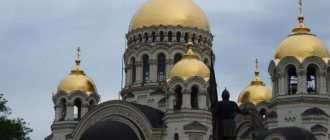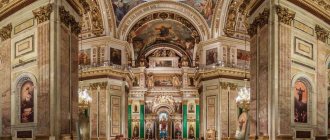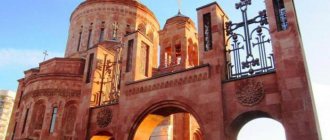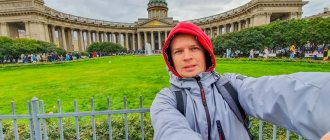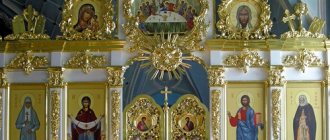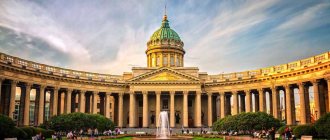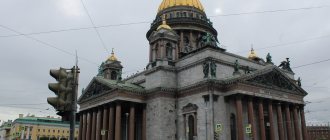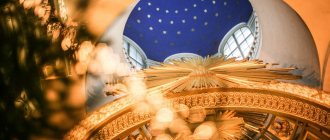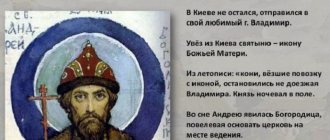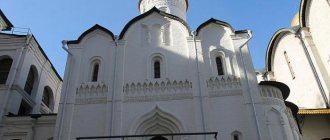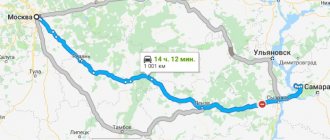Address: Nevsky Prospekt, 25. Opening hours: on weekdays from 08:30, and on weekends from 06:30 until the end of service. How to get there: metro station “Nevsky Prospekt” or “Gostinny Dvor” (exit to the Griboyedov Canal). One of the most beautiful, grandiose buildings is located on the central avenue of St. Petersburg. Initially, the temple was created as the main repository of the miraculous icon of the Mother of God of Kazan. Today, not only are the most valuable military trophies located here, but also the body of the Great Commander, Field Marshal M.I., rests here. Kutuzova.
Address of the Kazan Cathedral in St. Petersburg. How to get there
Location of the cathedral: Kazanskaya Square, 2, St. Petersburg. Near the temple of God there is a bus stop called “Nevsky Prospekt”. The following buses go here: No. 3, 3 M, 3 MB, 4 M, 4 MB, 5 M, 5 MB, 24, 27, 191. Of the trolleybuses, No. 1, 5, 7, 10, 11, 22 are suitable.
You can also get to the temple by trolleybus number 17, getting off at the Kazan Cathedral public transport stop. In the area of Voronikhinsky Square there is a stop “Ploshchad Kazanskaya”, which can be reached by minibus No. k-306 or bus No. 100.
There are several other quick and convenient ways to get to the temple - call a taxi, rent a car, or drive your own car. The journey from Pulkovo Airport to the temple will take approximately 30 minutes. From the bus station it takes 8 minutes (4 km).
The Kazan Cathedral can be reached from 5 railway stations in St. Petersburg:
- Moskovsky station: distance approximately 2 km, the journey is only a couple of minutes.
- Baltiysky Station: 4 km (7 min.).
- Vitebsky railway station: 2 km (4 min.).
- Ladozhsky station: 7 km (15 min.).
- Finland Station: 4 km (7 min.).
You can get here by metro. The final stop is called “Nevsky Prospekt”. The exit from the subway looks at the church building. You need to head towards Palace Square. In a couple of minutes, the Cathedral of the Kazan Icon of the Mother of God will be visible on the left. The closest metro stations to it are Gostiny Dvor and Admiralteyskaya.
Two hundred years of history
Kazan Cathedral is located on Nevsky Prospect, located in the city of St. Petersburg. It was named after the city shrine located within its walls - the Kazan Icon of the Mother of God.
The prototype of the project was St. Peter's Cathedral, which the future Emperor Paul 1 saw while traveling around Europe. Admiring its beauty and harmony, he wanted to recreate a similar ensemble in the capital.
The approved project was presented at a special competition. It was supposed to replace the old Church of the Nativity of the Virgin. Its author was the young architect Andrei Nikiforovich Voronikhin.
The peculiarity of this cathedral is that the site provided, with its long side, was located from west to east and was not suitable for its construction, since according to church canons the altar should always be located in the eastern part of the temple.
But the architect, when creating this project, placed a colonnade in the side facade, visually turning it into the main entrance. The laying of the first stone took place in 1801, on August 27, after the death of Paul 1. Emperor Alexander 1 was present at the ceremony.
In addition to its church purpose, the Kazan Cathedral bears the title of a monument to Russian military glory. It contained captured banners of the French army, as well as flags and keys to European cities obtained during the campaigns of conquest after the War of 1812.
Subsequently, monuments dedicated to the great commanders M.I. Kutuzov and M.B. Barclay de Tolly were erected in front of the cathedral, and after his death, the great commander himself, M.I. Kutuzov, was buried near its walls.
The construction of the cathedral began the golden age of Russian architecture. This grandiose monument, striking with its magnificence, has lasted more than one generation. It was built in a fairly short time - only ten years.
Such a large-scale project was developed by the talented architect Andrei Voronikhin, the future famous architect of the Kazan Cathedral in St. Petersburg. The tallest church in the capital was built by order of Paul I for the miraculous copy of the icon of the Blessed Virgin Mary, given to Peter I by his relative.
After a long presence in the Church of the Nativity of the Theotokos, the icon was transferred to the cathedral erected in its place and became one of the most revered Orthodox images in St. Petersburg.
Visiting hours for the cathedral, located at 25 Nevsky Prospekt, begin at 8:30 on weekdays, and on holidays and Sundays at 6:30. They end after the end of the evening service.
The temple was built by a huge number of talented serfs in very difficult conditions, with virtually no use of technology. However, with the hands of ordinary working people, in the name of Orthodoxy and the Motherland, the majestic Cathedral of the Kazan Icon of the Mother of God was erected, St. Petersburg acquired a unique Russian architectural masterpiece and completely assumed the appearance of the luxurious capital of a powerful empire.
In the thirties of the twentieth century, the temple was violated, it was closed, and instead of God’s place, a museum on atheism and religion was built in it. Services were resumed in the temple only in 1991.
We moved to Antalya. We tell you everything in detail in our group. in contact with: https://vk.com/antalya2. Also watch our videos at YouTube:
Find excursions in St. Petersburg >>
Story
The Kazan Cathedral in St. Petersburg was built at the beginning of the 19th century. This is the burial place of I. Kutuzov. Here are the keys to captured settlements, as well as enemy loot.
Church of the Nativity of the Blessed Virgin Mary
In 1733, construction began on the Church of the Nativity of the Blessed Virgin Mary, which had a wooden dome and a bell tower. The design of the church was created by Mikhail Zemtsov. The niece of Peter I, Empress Anna Ioannovna, was invited to the consecration of the temple. The image of the saint was brought to the church a day before the religious ceremony. 1747-1748 are marked by the creation of the temple face of the “Nativity of the Virgin Mary”.
In this church, the son of Catherine II and Peter III, the All-Russian Emperor Pavel Petrovich, received the blessing of marriage. Most victories in military battles were celebrated here.
In the mid-18th century, the architect Semyon Volkov created a scheme for the updated bell tower to give the cathedral greater solemnity. But the idea remained unfulfilled.
Construction of the Kazan Cathedral
Paul I in the last decade of the 18th century decided to build a new cathedral instead of a dilapidated church building. The best architects proposed their projects, but no one's idea was approved by the emperor.
In 1800 Stroganov A.S. came to the emperor with another scheme for building a temple, the author of which was the brilliant A. Voronikhin. This project was approved, Stroganov was given the position of head of the board of trustees during the construction of a religious building.
The following year, the construction of a new church began, in which Alexander I took part. Engraver N.F. Alferov helped the chief architect build the cathedral on a voluntary basis.
Construction lasted 10 years, its total cost was almost 5 million rubles. The creator of the project was awarded the Order of St. Vladimir, 4th degree. Metropolitan Ambrose consecrated the temple in the year of its opening. It was then that the old building was demolished.
Cathedral in the 19th – early 20th centuries
For people, the religious building was the object of the military achievements of the Russian population in the Patriotic War of 1812. Sacred objects obtained in the war are kept here: a staff belonging to Davout (Marshal of Napoleon), military flags of France.
Under the leadership of Auguste Montferrand, finishing work continued in the church until the end of 1829. The restoration of the temple was carried out for the first time in 1844-1845. Next time - in 1862-1865. with the restoration of church faces and paintings on the walls. At the end of the 19th century, the body of P. Tchaikovsky was brought to the temple for the funeral ceremony.
The cathedral building was extremely popular among the radically minded population. Youth demonstrations were held here, starting at the Anichkov Bridge. In 1905, people made barriers from benches in the newly formed park near the temple.
In February 1913, the 300th anniversary of the formation of the Romanov dynasty was celebrated in the master building. On this day, 34 people died as a result of crowd movements. After 4 years, the people chose Veniamin of Gdov as the ruling bishop.
Since the 1930s
Religious communities of Christians were oppressed by the Soviet regime. These persecutions also affected the Kazan Cathedral. Its decoration became less attractive after objects of religious significance were removed from the temple in the 2nd decade of the 20th century.
According to supposed information, approximately 2000 kg of silver were taken from here. The iconostasis disappeared, the silver of which disappeared in an unknown direction.
In the 30s of the 20th century, the temple was closed, and a little later the Museum of the History of Religion and Atheism was formed here. After 20 years, its appearance was updated, and after another 10 years, the outer side of the structure was restored.
In the USSR, the Kazan Cathedral in St. Petersburg was a museum of the history of religion and atheism. The photo shows the booklet
Since 1991, religious ceremonies have returned to the left side of the room. In 1992, the main building was consecrated. Metropolitan Vladimir completely consecrated the temple in 1998.
Kazan Cathedral
The church had a court purpose. In 1773, the wedding of Tsarevich Pavel Petrovich took place there. Army victories were also celebrated here. By the end of the 18th century, the temple had become seriously dilapidated, and Paul I announced a competition for a project to build a new St. Petersburg church to replace it.
Creation of the Kazan Cathedral
The imperial decision approved the plan of the architect A. N. Voronikhin, who was beginning his master's career, who was once a serf of Count Alexander Sergeevich Stroganov, the president of the Academy of Arts.
I read that the count himself was appointed chairman of the board of trustees organized during the construction of the cathedral, which lasted a decade (1801–1811). For his grandiose work, Andrei Nikiforovich Voronikhin was awarded the Order of St. Vladimir, IV degree.
The cathedral was consecrated by Metropolitan Ambrose on September 27, 1811. About 5 million rubles were transferred from the state treasury for the construction of this magnificent temple.
The cathedral becomes a monument to Russia's triumph over Napoleon in the Patriotic War of 1812. In 1813, in its left aisle there is the tomb of the brilliant Russian field marshal M.I. Kutuzov, whose body was brought to St. Petersburg in June from the Prussian city of Bunzlau. A bronze fence was erected at the burial site (by A. N. Voronikhin) and five standards and one banner were installed, which have survived to this day.
An icon of the Smolensk Mother of God was placed above the grave itself. In the temple space of the cathedral, 107 “captive” banners and standards of the French army were also hung (most of them are kept in Moscow today), as well as 97 bunches of keys from conquered fortresses and cities of France. I think you will also pay attention to the two grandiose monuments to Kutuzov and Barclay de Tolly opposite the Kazan Cathedral.
They were erected in 1837 in memory of the events of the Patriotic War with Napoleon.
Cathedral in the 19th – early 20th centuries
Even today I am amazed by the magnificent facades of the Kazan Cathedral, although some of them have now been lost. Made of Pudozh stone, they were generously decorated with sculptural compositions and bas-reliefs. The most famous masters of that time worked on this splendor: I. P. Martos, I. P. Prokofiev, V. G. Godeev, V. I. Demug-Malinovsky.
The bronze northern gate was made like the “Heavenly Doors” of the Baptistery of Florence (15th century).
I am very sorry that not all of this beauty has survived to this day. True, 56 gigantic columns made of pink granite from Finland, in my opinion, even today inspire a feeling of steadfastness, grandeur and reliability. The stucco molding of the temple belonged to the works of F. Toricelli and B. Medici. The iconostases were made by A. Leblon and F. Chrétien. The images, most of which are today in the Russian Museum of the Northern Capital, were painted by O. A. Kiprensky, F. P. Brullo and other prominent masters.
The temple was filled with light by a beautiful chandelier of 180 candles (the work of J. Guerin). On the day of the illumination of the Kazan Cathedral, the miraculous Image of the Virgin Mary of the same name was dressed in a magnificent golden robe, decorated with precious stones and pearls. From 40 pounds of trophy French silver, architect K. A. Ton completed the facing of the main iconostasis. Later, in 1884, an 11-pound silver tomb for the shroud appeared in the cathedral, and in 1890, chased banners appeared.
At the beginning of the 20th century, in 1903, the townspeople had an unusual idea - to create the same mighty belfry near the Kazan Cathedral, but the Academy of Arts wisely rejected this intention. For the 100th anniversary of the cathedral, a number of restoration works were carried out under the guidance of the best architects and artists, including my favorite diocesan architect A.P. Aplaksin.
It was he who wrote the words: “With the Kazan Cathedral, Russia became equal to Europe, ... rising highly to the level of the image of beauty.”
The magnificent interior decoration, revered shrines, church utensils, which themselves were works of art, in a word, all this created an indelible feeling of beauty among the parishioners. And the memorial plaques located here, bas-reliefs of Paul I and Alexander I, as well as the tomb of M. I. Kutuzov reminded of the imperial glory of Russia.
It was from here that every year on September 12, a solemn religious procession to the Alexander Nevsky Lavra took place along Nevsky Prospect (you can read about it in more detail in my article here), in which imperial persons and holders of the Order of the Holy Blessed Prince Alexander Nevsky certainly took part. By the way, I was interested to learn that previously this day was an official holiday in St. Petersburg. Other solemn religious processions were also performed in the Kazan Church.
The patronal holiday - the day of the Kazan Mother of God, celebrated on July 21 and November 4, gathered a lot of townspeople in the cathedral. Due to this, a prayer service in front of the miraculous icon was held right on the street opposite the cathedral.
On the day of remembrance of Equal-to-the-Apostles Cyril and Methodius, Slovenian enlighteners, on May 24, many students flocked to the Kazan Church. On the feast of St. Sava of Serbia, which falls on January 27, the capital's Serbs came here. A special thanksgiving prayer was held here on January 7 (new style) - Victory Day over Napoleon.
In the same church, on November 8, 1893, the funeral service was held for my beloved great Russian composer Pyotr Ilyich Tchaikovsky.
That is, the Kazan Cathedral, from the beginning of its existence until the revolutionary coup of 1917, fulfilled not only its direct spiritual mission - serving the liturgy - but also reflected all the cultural and historical events of Russia, being an outstanding monument to its military glory.
I myself learned with interest that shortly before the revolutionary events of 1917, it was in the Kazan Cathedral that, for the only time in the history of the St. Petersburg diocese, the election of the ruling bishop was held through a free vote of the clergy and laity. He became the future martyr Veniamin (Kazansky).
In January 1921, even before the closing of the cathedral, it was he who consecrated the chapel of the holy martyr Hermogenes, Patriarch of Moscow.
Soviet period
After the process of requisitioning church valuables in 1922, during which Metropolitan Benjamin (Kazan) was innocently shot, the interior of the cathedral was also badly damaged. One piece of silver weighing about 2 tons was taken from it, as a result of which the unique silver iconostasis perished in the melting crucible. I was surprised that, despite the increasing repressions, there was still an almshouse for elderly women here until 1925, and the parish remained numerous. Missionary and charitable activities did not stop.
Since 1928, the temple was handed over to the “renovationists”, and since the beginning of 1932 it has been closed.
The GPU set up warehouses in the basements of the temple. In my opinion, the real blasphemy was that in the cathedral, which meant so much for Russia, the new authorities decided to create nothing more than a Museum of the History of Religion and Atheism.
I had a chance to visit there as a child. There was a feeling of emptiness, heaviness and heartfelt bewilderment. But all this is now in the past.
Restoration of spiritual life in the Kazan Cathedral
In the early 90s of the 20th century, the cathedral began to gradually return to its true purpose. And I am glad that I, together with my friends, witnessed this revival. In the fall of 1990, in the storage rooms of the Museum of Atheism and Religion, located in the Kazan Cathedral, the relics of St. Seraphim of Sarov, lost during the years of repression against the church, were found. The solemn service on the occasion of their discovery was led by Patriarch Alexy II. From Leningrad on February 6, 1991, the holy relics were sent on the Red Arrow train to Moscow. At that time, the authorities were still trying to prevent wide publicity of what had happened, but, nevertheless, a huge crowd of people gathered to see St. Seraphim off.
Architecture and decoration of the cathedral
At the request of the emperor, the church should resemble the imposing St. Peter's Basilica located in Italy. Fulfilling his wishes, Voronikhin built a huge wall near the temple, consisting of 96 columns. This grandiose colonnade opens in the direction of Nevsky Prospekt in St. Petersburg.
The front side of the building is covered with light calcareous tuff (Pudost stone). Previously, the cathedral building was decorated with statues of local architects. However, only a couple of pedestals on the side of the colonnades have survived to this day. Until 1824, angelic figures made of plaster were located on top of them. Later it was planned to put bronze sculptures in their place.
The Kazan Cathedral in St. Petersburg has about 55 columns of the Corinthian order, made of Finnish pink granite with golden capitals. Of the relief sculptures in the decoration of the temple, only “Carrying the Cross” (Shchedrin F.), as well as “Taking into Custody” (Rachette J.) have survived. Others were removed in 1814.
The altar partition of the main part of the room had an attractive appearance. It was erected in place of the original iconostasis and decorated with French silver. Later, the altar partitions of other parts of the cathedral were also covered with silver. The iconostasis was lost after the disappearance of church relics. Today it has been completely restored.
A little history: how the Kazan Cathedral was built
@k0r0vk1n
Paul I wanted to create it in the image and likeness of St. Peter's Basilica in the Vatican. To implement the plan, a competition was announced for the best architect. Charles Cameron won, but before he could get to work, Pavel was presented with another project. Count Stroganov recommended young Andrei Voronikhin, who did not participate in the competition, to the emperor. Pavel was so impressed by Voronikhin's plan that he was immediately appointed chief architect.
The construction of the cathedral began after the death of Paul I. In 1801, it was founded by Alexander I. Construction lasted ten years, and 4.7 million rubles were spent on it.
Voronikhin managed to design a colonnade similar to an Italian cathedral. However, 96 columns are not located along the perimeter, like the Vatin model. They are directed towards Nevsky Prospekt. According to Orthodox tradition, the altar of the church should face the east, and the main entrance should face the west. To comply with it, Voronikhin had to make the side façade the main one.
Contemporaries believed that Voronikhin borrowed too much from European architects. In particular, the idea for the north gate in bronze was taken from Lorenzo Ghiberti, the designer of a 15th-century Florentine temple.
Shrines, relics
The main relic of the Kazan Cathedral is the Miracle-Working Icon, which was found in Kazan in 1579. The shrine was brought to St. Petersburg during the reign of Peter I. It was owned by Tsarina Praskovya Fedorovna.
In 1604, after Ivan the Terrible attacked Kazan, the city was engulfed in flames. The house of the archer Onuchin was completely burned down in a fire. He had a daughter named Matryona, who was 8 years old at that time.
The girl dreamed of the Mother of God. She told her that the Miraculous Icon could be found under the ruins of a room destroyed in a fire. Matryona independently found the icon, which looked like new.
Most likely, the holy image was buried underground long before this event. After the discovery, miracles began to happen that continue to happen to this day. Therefore, over time, a monastery was built at the site where the icon was discovered.
It was believed that the Kazan Icon of the Mother of God helped to achieve victory in military operations, so many copies of it appeared. The holy image, which ended up in St. Petersburg, was the cause of great church holidays. It was actively used during the crusades, including Kutuzov and many commanders of the Soviet period in the Battle of Stalingrad.
During the reign of Soviet power, the icon was given to the Prince Vladimir Cathedral, but in the 1990s. returned back to the Kazan Cathedral.
History of the Kazan Temple
The history of the Kazan Cathedral dates back to the 17th century.
Church founding
The first Kazan Cathedral was wooden - it was built in 1625 at the expense of Dmitry Pozharsky, in memory of the victory of Rus' in the Battle of Moscow. It was erected on the site of shopping arcades, and for many years the poet remained at its fence, a small market familiar to the townspeople.
The cathedral itself at that time was not yet a cathedral - it was a small temple with two boundaries, preserving the Moscow copy of the Kazan Icon of the Mother of God, which was then the main shrine of the people's militia.
More than a hundred years after the construction of the temple, until 1765, religious processions were held there on the day of the capture of Kitay-Gorod and the discovery of the miraculous icon.
In 1650, there was a fire, and the cathedral was rebuilt, and in the middle of the 17th century, Archpriest Neronov and Avvakum Petrov, priests who did not accept the church reform, served in it. According to legend, they were arrested in the temple.
Use of the cathedral
The Kazan Church was repaired and expanded many times, and all this time services were held in it. Some interesting events include:
- 1812 - a large prayer service for victory in the war in front of the Moscow Kazan Icon, which was attended by Kutuzov himself;
- 1918 - the theft of a list from the Kazan icon, which was revered by many Moscow believers as miraculous and was never found;
- 1918 - Patriarch Tikhon’s big sermon about the execution of the royal family.
After the revolution, services were no longer held in the cathedral.
Figure 2. Kazan Cathedral, early 20th century
Dismantling of the Kazan Cathedral
In 1929 the bell tower was demolished, and in 1936 the entire temple of the Icon of the Kazan Mother of God in Moscow ceased to exist.
A summer cafe and fountain were installed in its place. And until 1990, there was no talk of any reconstruction of the temple - the Communist Party was strongly against it.
Restoration of the temple
However, the USSR collapsed, but the memory of the cathedral remained. In 1990, the Moscow government decided to restore it. This was done by architects Gennady Mokeev and Oleg Igorevich Zhurin. A year later, a silver cross was laid into the foundation of the temple, and in 1993 a solemn consecration was carried out and appropriate prayers were offered.
The architecture of the temple remained the same, the same as in the 17th century. It became the first of the restored churches in Moscow to return to life in its previous form.
Temple-monument
Mikhail Kutuzov was taken on his last journey and buried in the church. Based on the image of the architect Voronikhin, a partition was made that separated the burial place of the Grand Duke from the marble slab located above.
The Kazan Cathedral in St. Petersburg stores over 100 flags and banners of destroyed French military units, more than 90 keys to defensive points that were captured by Russian troops.
In 1837, celebrating the victory over Napoleon, the official opening of monuments to famous Russian military leaders: M. Barclay de Tolly and M. Kutuzov took place near the Kazan Cathedral. The famous architect V. Stasov became the author of the idea, and the images of the commanders-in-chief were made by the sculptor B. Orlovsky.
The monuments reminded of the enormous significance of the temple. They immortalized the heroic deeds of the Russian army for the benefit of the Motherland. Not far from the royal place in the second half of the 19th century, under glass there was a written appeal from the highest body of ecclesiastical authority of the Russian Orthodox Church about the death of Alexander II. Nearby hung a message about the Holy Alliance.
Architectural appearance of the temple
By the will of Paul I, the external appearance of the cathedral was designed to be similar to the Roman Catholic Church of St. Peter in the Vatican. Therefore, the Kazan Church has a number of features that are unusual in the architectural styles of Orthodox cathedrals of that time: the presence of a colonnade on the outside and only one dome. The Cathedral is a grandiose creation of human hands, striking with its external and internal decoration.
The Kazan Cathedral was erected in the French imperial Empire style; the architect Voronikhin and the sculptor Gordeev, together with other outstanding artists of the nineteenth century, worked hard on the basilica form of the temple and the sculptures richly decorating the cathedral.
Relief works crown the outside of the Kazan Cathedral - sculptor Pimenov, in tandem with other talented artists, created beautiful bronze sculptures of great saints. The St. Petersburg Cathedral is the first church in the Russian Empire created in the European style by a Russian architect.
Traditions
The church district of the Kazan Cathedral took part in the religious processions:
- anniversary of the death of the great Russian ruler Alexander Nevsky - August 30;
- Alexander II visited the church to pray before the Miraculous Icon after D. Karakozov encroached on his life - April 4;
- The city was completely healed of cholera - July 4th.
Holidays were celebrated in the Kazan Cathedral, where the majority of the population of St. Petersburg took part:
| date | Name of the holiday | Description |
| 08.07 | Patronal holiday | A short service (prayer service) in front of the icon of the Mother of God in the center of the street on a special platform made of boards. |
| 11.05 | Day of Saints Cyril and Methodius | A prayer service and liturgy were held, where many students from parochial schools came. |
| 14.01 | Saint Sava of Serbia Day | The capital's Serbs celebrated. |
| 25.12 | Victory over the enemy in the Patriotic War, which took place in 1812. | Special church service |
Abbots
Since the opening of the Kazan Cathedral, the following abbots have served here:
- Syrokhnov Ioann: from 1811 to 1814 He was appointed rector at the end of 1810. Almost nothing is known about his biography. Only that after studying at the theological seminary in Pskov, he served in the St. Nicholas Church in Vitebsk for more than 10 years. He had a wife and 4 children. It is unknown when and where he was buried.
- Bedrinsky John: 1814-1831 He put the cathedral's construction accounts in order. At this time, a large flood began in St. Petersburg, as a result of which the church had to be restored. During his abbotship, the funeral ceremony for Count M. Miloradovich and Alexander I was carried out.
- Myslovsky Peter : 1831-1846 During the period of the rector’s service, monuments to Kutuzov and Barclay de Tolly were erected, and the temple was restored.
- Nikolsky Timofey: from 1846 to 1848 During his tenure, several episcopal consecrations were held in the cathedral, and the altar partition of the church, which had become dark, was washed.
- Raikovsky Andrey : 1848-1860 During his ministry, a new religious procession was introduced as a reminder of cholera, which killed a large number of residents.
- Debolsky Gregory: from 1860 to 1881 Over the years of his abbotship, major repairs and restoration were carried out in the temple, the 50th anniversary of the cathedral was celebrated, the old frames were replaced, and the paintings on the walls were restored.
- Bulgakov Alexander: 1881-1883 During his work, the applied decorations on the icon were updated, and the process of decorating the throne with silver was launched to harmonize it with the iconostasis.
- Lebedev Alexander: 1883-1898 Thanks to him, the structure for hanging bells (belfry) was repaired, the stables and carriage houses were rebuilt. New chandeliers were hung with him, the icons were placed under glass so that dust would not accumulate on them. A building was purchased and turned into a shelter for the elderly, children and women in a helpless state.
- Megorsky Evgraf: 1898-1904 During his abbotship, the roof of the temple was repaired, and the cathedral was equipped with electricity. The archpriest organized a church and school holiday.
- Megorsky Dimitri: 1904-1909 Most of all he was worried about the church economy of the temple. He introduced his own financing structure and brought public affairs into proper shape.
- Sosnyakov Nikolay: from 1909 to 1913 During his tenure, the 100th anniversary of the opening of the cathedral was celebrated. He was fully engaged in preparatory work for the anniversary. The temple under him underwent a thorough renovation. The priest also prepared everything necessary to celebrate the 300th anniversary of the reign of the Romanov dynasty.
- Golovin Nikolai: 1913. The main task of the rector was to introduce the poor population into the church and guide the poor on the right path.
- Ornatsky Philosopher: 1913-1918 He was a true patriot of the Motherland, helped the army, organized material assistance to Russian troops, provision of warm clothes, and assistance to family members of wounded soldiers.
- Marenin Vasily: 1918-1920 On the occasion of the celebration of the 100th anniversary of the cathedral, he delivered a solemn speech. By the time he was appointed rector, the priest suffered from various ailments, and was also of advanced age. Therefore, it was decided to give him N.K. to help him. Libina. Father Vasily created a new chapel, which was consecrated by Father Veniamin in 1921.
- Chukov Nikolay: 1920-1923 He was appointed rector at the end of 1920, and in May 1922 he was arrested with a strict punishment and confiscation of property. However, it was decided to replace the execution with imprisonment for a period of 5 years. In 1923, Father Nikolai was released from custody.
- Hegumen Sergius: 1991-1996 After a long break, the cathedral began its work again under his leadership.
- Krasnotsvetov Pavel: from 1996 to the present time. He carried out the procedure for consecrating the church to the fullest extent. Worship services have resumed on a regular basis. The church aisles and iconostasis have been restored. Restoration work is still being carried out.
Schedule of services
Services are held regularly in the temple. It is open from Monday to Friday from 07:00. 00 min., on Sundays and holidays - from 06 o'clock. 30 min. Finishes work at the end of the evening service.
Schedule of services on weekdays, Sundays and holidays:
- 07 o'clock 00 min. – early Divine Liturgy, confession begins;
- 10 o'clock 00 min. – late liturgy, at 09:00. 30 min. confession begins;
- 6 p.m. 00 min. - Beginning of the evening service.
Throughout the day, baptism and confirmation, weddings, repentance, and funeral services for the departed are performed. You can find a clergyman here at any time.
Rules and cost of visiting the cathedral
While on the territory of the cathedral, you must adhere to the following rules:
- Put your phone on silent mode or turn it off completely; the phone can only be used for photography purposes.
- Women should put a headscarf on their heads, and men, on the contrary, should take off their headdress. Girls need to choose modest styles of clothing that cover the shoulders and a deep neckline on the chest. It is unacceptable to come in miniskirts, shorts, or women's trousers.
- You are not allowed to take photos during the service. The use of flash is not permitted.
- Maintain cleanliness in the temple, do not disturb the silence. Communicate only in whispers.
The Kazan Cathedral in St. Petersburg prohibits the following actions on the part of parishioners:
- carry any type of weapon;
- use firecrackers, fireworks, open fire;
- bring food, water;
- take animals with you;
- be drunk, narcotic or other toxic intoxicated, drink any alcoholic beverages, smoke;
- take any type of photography using additional objects (selfie stick, tripod) in the absence of written permission with a resolution from the rector of the cathedral;
- be on the territory of the temple for commercial or advertising purposes;
- visit office premises without permission;
- leave trash on the church grounds.
Excursions
The cathedral has a tour service. Opening hours: every day from 10 a.m. 00 min. until 18:00 00 min. This service is located near the exit to Kazanskaya Street. Guests are offered individual as well as group excursions. If necessary, you can agree on it in advance for a specific date and time.
To engage in activities providing private tour guide services, you must obtain permission and sign an agreement.
For an excursion, you should gather a group of people interested, indicate the number of participants, the name of the organization, and receive a badge, which indicates permission to conduct an excursion on the territory of the church.
Private guides have the right to carry out their activities only from 11 o'clock. 30 min. until 18:00 00 min., when there are no services.
In groups of more than 20 participants, it is necessary to use the “radio guide” function. This rule was introduced in order not to disturb those who are praying.
Interesting facts about the cathedral
Information about the Kazan Cathedral that cannot be ignored:
- the cathedral is named after the icon of the Mother of God;
- work on the temple project brought Voronikhin considerable profit, which ensured his comfortable existence;
- in order to attend Tchaikovsky’s funeral service, 800 tickets were purchased; his compositions were distributed during the liturgy;
- in the 19th century, for the first time in history, workers who were not satisfied with the tsarist regime gathered near the church;
- over 600 kg of silver were spent on the iconostasis;
- the builders mostly came from serfdom;
- soldiers went from the temple to the battlefield;
- More than 10 houses were destroyed during construction.
Kazan Cathedral is one of the largest buildings in the city. When coming to St. Petersburg, a visit to the temple is necessarily included in any excursion program. Every year more than a thousand foreign tourists and compatriots come here.
Author: Ekaterina Pisarenko
Article design: Mila Friedan
Appearance of the object
The Cathedral of Our Lady of Kazan in Moscow is a classic representative of the single-headed type with a hill of kokoshniks, three chapels and a hipped bell tower on the north-west side. Despite the apparent complexity and multi-level nature of the cathedral's architecture, it creates the impression of harmonious integrity. According to historian P. Rappoport, the object can be considered a harbinger of the “patterned” era in Russian architecture.
The color scheme in the exterior decoration suggests that the temple was built as a military one. This is also confirmed by the fact that a list of the most revered icon in Orthodoxy of the Kazan Mother of God is kept here - it was her images that were on the banners of the Second National Militia, which managed to free Moscow from the intervention.

